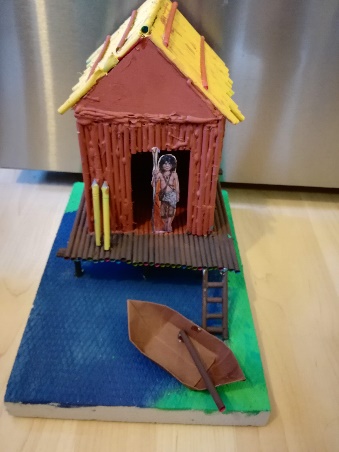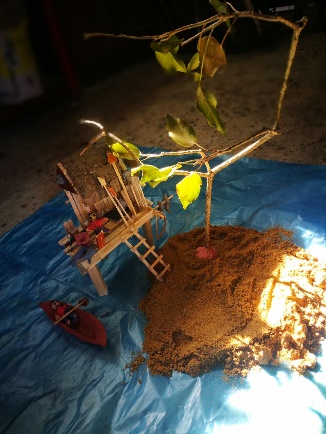Encouraging Movement During Distance Learning
Eva Slapnik holds a Master's in Primary School Education and teaches at the primary school level. She also completed a module for early English teaching. She enjoys teaching pupils, preparing them to think outside the box, and passing on knowledge that will come in handy in their future. Email: eva.slapnik1@guest.arnes.si
Abstract
In the past school year, all teachers have found themselves in a situation where we have been teaching at a distance. At the beginning of distance learning pupils were mostly extremely motivated, but then their motivation slowly began to fade away and they also lost the desire to move. As a result, the amount of assignments sent at the beginning of the school day demotivated them. Through cross-curricular integration, where we combined movement with other learning goals, we achieved higher motivation for student work. Their products have become more accurate, of better quality and their newly acquired knowledge more durable. We also encouraged them to move more often and thus take care of themselves and their body.
Introduction
We had an agreement with the fifth graders to send them their assignments in the morning, which they had to complete during the school day. In the meantime, they also had the possibility of meetings where we discussed any issues and problems. I noticed that the pupils were extremely motivated at the beginning of distance learning. Most of the pupils completed all of the assigned tasks carefully and accurately. Eventually, however, their motivation began to decline. I also often received feedback that they skipped tasks with sports activities because they were simply not motivated to move. Daily e-mails with a large number of attachments for each individual subject began to demotivate them, so I started with cross-curricular linking wherever this was possible, to include movement in my assignments. Fortunately, the pupils were old enough to be able to carry out outdoor activities independently and lived in such an environment where meadows and forests were close by so that they could move around in nature.
The need for movement is natural for humans. "When a child moves, he develops and strengthens his body, his motor skills are coordinated, and his skills are also trained in connecting individual physical and sports activities. With appropriate incentives in the family and later in school, we influence the child's later lifestyle and equip him for all independent and active management of trials, burdens and stresses that life will bring him (Škof, 2007, p. 27)."
Research has shown that play and outdoor learning are significantly related to physical development. It is established that spontaneous, relaxed and stimulating outdoor learning works on the memory process of each child in such a way that they internalize it and remember certain transmitted contents better (Pušenjak, 2009).
Today, we are increasingly focused on making the pupil the forefront of the learning process. Cross-curricular integration is one of the many didactic approaches that put the learner in this position. "It is already the case that a child is a curious being, to whom new insights, experiences and answers always open new questions, dilemmas, doubts, and this is the natural path on which development and learning, ability and guidance, thinking and emotions, information and creativity intertwine (Simsija, Strazberger, 2008, p. 521).”
The following are some examples of cross-curricular integrations that the pupils found extremely interesting and they were happy to participate in them.
Pile dwellers
We combined the contents of society, fine arts and sports.
We discussed the life of pile dwellers with the pupils. Their task was to investigate where and how the pile dwellers lived. Once they found all the relevant information, they headed out to nature where they collected the appropriate material to make a shelter for pile dwellers. Then, with the help of natural and also some waste materials, they created interesting dwellings for pile dwellers.


Pictures 1, 2, 3, 4 and 5: dwellings of the pile dwellers (personal archive)
Soil
We combined the contents of science and technology and sports.
Pupils took soil samples in different living environments and compared them with each other according to predetermined criteria. By walking through different living environments, they found out why soil differs from each other in different environments.
Weather
We combined the contents of science and technology, society, sports and fine arts.
During the execution of the science day, which actually stretched into a week, the pupils touched on quite a few different subject areas through various activities. In the first activity, pupils made two barometers. The first was kept at home, the second was taken to a nearby hill. They also made a wind bag, which they also took to a nearby hill. Then their task was to observe every day whether the air pressure was high or low, they also checked the strength and direction of the wind. At this point, they also checked the weather every day. All data obtained was carefully recorded in tables. Every day, after writing down all the information, they also spent time relaxing and meditating. They lay down on the ground and watched the clouds. Cloud data was also then entered into the tables.
Bela Krajina
We combined the contents of society, music, sports and household.
While watching the videos, the pupils got to know the natural and social characteristics of Bela Krajina. They took notes on their own. They found a recipe for Bela Krajina cake online and baked it with the help of their parents. At the meeting, we sang a Bela Krajina song together, which they learned in their music class. We then watched the Bela Krajina dance together. The pupils then also learned it. They danced with their family members. If desired, they could also record and play the recording at our joint meeting.
Geometric bodies and adjectives
We combined the contents of mathematics, Slovene and sports.
The pupils had the task to create a polygon with objects that they found around the house or flat. They were given a list with some requirements for how the polygon should be composed. Geometric bodies and adjectives (mom's, wooden, black…) were written on the list. Of course, they could also add their objects to the polygon, which do not have the shape of a geometric body or cannot be associated with any written adjective. They had to overcome the polygon with various forms of movement (jumping, crawling, walking backwards...). Each pupil then also drew the polygon and presented it at a joint meeting.
Despite the fact that preparation of interdisciplinary classes requires much more work and organization, I am happy to tackle them, as pupils learn a lot during such classes. I find that pupils connect the newly acquired knowledge much easily and they learn that the material in individual subjects is connected and not strictly separated. The advantage of interdisciplinary connections is also that we can include sports or movement almost everywhere.
Literature and sources
Pušenjak, M. (2009). Radost v naravi, radost v igri. Acquired 23. 1. 2021 from http://www.zzv-lj.si/promocija-zdravja-in-zdravstvena-statistika/zdravje-v-vrtcu/dosedanja-izobrazevanja/predstavitev-primera-dobre-prakse-marija-pusenjak.doc.
Simsija, S. in Strazberge, I. (2008). Medpredmetno povezovanje matematike s spoznavanjem okolja v 1. razredu ter naravoslovjem in tehniko v 4. razredu na razredni stopnji. In J. Krek, T. Hodnik Čadež, J. Vogrinc, B. Sicherl Kafol, T. Devjak, V. Štamberger (Ur.). Učitelji v vlogi raziskovalca (p. 521−545). Ljubljana: Pedagoška fakulteta Univerze v Ljubljani.
Škof, B. (2007). Šport po meri otrok in mladostnikov. Ljubljana: Fakulteta za šport.
Photographs come from a personal archive.
Please check the Pilgrims f2f courses at Pilgrims website.
Please check the Pilgrims online courses at Pilgrims website
Encouraging Movement During Distance Learning
Eva Slapnik, SloveniaSome Lonely Words
Tim Bowen, UKLet's Learn to Listen
Eva Slapnik, Slovenia